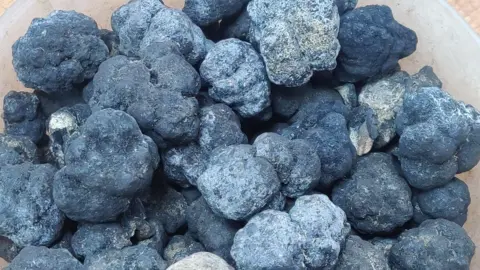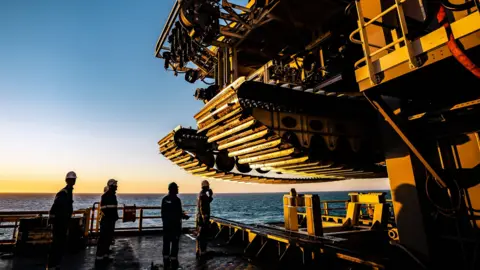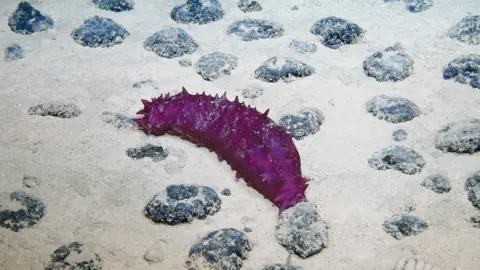Technology reporter
 Getty Images
Getty ImagesThere is one. And another. This robot was hunting for rocks. A three -wing claw descended from above and grabbed a stone from the seabed.
All the time, the autonomous car camera on board scanned creatures that can rely on those rocks, to avoid abducting an innocent form of life by its habitat.
Evidence, performed in a port in NovemberDemonstrated an approach to mining for polyimetallic joints, potato -size bumps containing metals scattered in the seabed in large quantities, in much deeper parts of the ocean.
For example, such metals are required for use on renewable power equipment and batteries. But deep sea mines are a controversial tool to get them because of its potentially significant environmental impacts.
“We have felt that a vehicle he used to seek life and avoid it may have much less an environmental trace,” explains Oliver Gunasara, co -founder and chief executive of the impossible metals.
The firm’s system is 95% accurate in detecting life forms by 1 mm or larger size, he says.
The robot wings are similar to those who choose and place items in automated warehouses – they are optimized for speed. Plus, each claw begins a relatively small sediment clutch as it removes its target from the sea. Impossible metals aim to further reduce this concern.
Such a system is not likely to convince everyone that mines in the deep sea are a good idea, however.
“Mining by its nature would remove the life substrate itself inside and in the deep sea, regardless of technology,” says Jessica Battle, who directs the global mining initiative to a deep sea in WWF.
The deep sea mines are very controversial because the deep sea bed is more or less untouched and is still relatively poor. “If you’re not sure what’s there, then leave alone,” John Childs says at Lancaster University. “This has been the widespread position by science [to date]“
The scaries left by mining experiments in the past, using very divisive technologies, have been heavy.
In 1979, mining equipment in the deep sea made big songs in a part of the Pacific Ocean Sea and these remain there today, scholars say. Wild life is reported to have Still has not fully returned in the area 40 years later.
Opposition to the deep sea mines has been harsh enough to scope entire companies.
Nautilus Minerals tried to begin work on deep sea mining in the late 2010s. Following protests and financial concerns, the company went Bankrupt in 2019.
Minerals found in the deep sea, including manganese, nickel, cobalt, gold and silver, are considered all important materials for the transition of green energy.
Currently, such metals are derived from mines on the ground, which themselves have a significant impact on the environment.
 Impossible metals
Impossible metalsNo commercial operation of deep sea mines is taking place today, though this may change this year if the first group of international regulations regulating these activities is published, perhaps in July.
Mr. Gunasekara’s firm is currently building a larger version of his robot in a 20 -foot transport container, large enough to perform trade -scale operations. There will be 12 wings of robots with grabbed claws.
He adds that the “hundreds” of such bots would have to harvest the seafood at one time, bringing loot to a ship to the surface. The recovered nodules would then be transported to land processing sites.
Unlike some other methods, in which heavy subsea devices are connected to support ships, the impossible metal vessel will not have to remain in the correct place for a long period, means that its engines would not create so much noise. This would reduce the impact on wildlife, claims Mr. Gunassekara.
He also argues that deep sea mines will reduce the need for mines on Earth: “Anyone who does not want to make mines in the deep is saying implicitly to make more land -based mines.”
Jovana Jovanova at Delft University in the Netherlands is working on a different system of robot wings that can collect metals from the sea. She points out that those working in this area should seek to develop “in synchronous” technology with the environment.
However, some deep sea materials can be removed using more invasive methods. SEEAB Solution, a Norwegian firm, is working on a saw -based device to extract crusts or layers containing minerals. The company says it is trying to reduce the volume of the sediment disturbed by the process.
“You protect the cutting area and make sure it is under pressure,” says Managing Director Bård Brekke Jørgensen. “You have a suction head interface [on] Your cutting tool ”.
 Getty Images
Getty ImagesMetals, a firm launched by former Nautilus Minerals Gerard Barron, is working for another technique.
Mr. Barron, the chief executive, is strong for the company’s prospects, despite the protests and lawsuits his firm has faced. Among the problems is a classroom action lawsuit filed by investors for reporting company income by a partner company in 2023 – Mr. Barron says “there is nothing in it.”
Those who call for a moratorium in the deep sea mines are the “signaling of virtue” he says, adding that Trump’s new administration in the US can help his company.
“We have many of our best supporters who assume very important roles in the new administration,” says Mr. Barron.
Metals company aims to submit a request for deep sea mines in the Pacific Ocean with international sea authority (ISA) later this year. Isa still has to confirm how it would regulate such activities.
 Company metals
Company metalsThe Dutch company Allseas, which is working with the firm of Mr. Barron, has developed mining machinery to scratch the polyimetal joints from the sea and send them to a surface support ship.
Company metals Its own tests suggest That waste waste created by this process would spread to hundreds of meters from the mining area, rather than many kilometers, and that the gradually deposited sediment is cleaned over time.
The claims that the sediment would be distributed many kilometers from the mining area were “total folly,” says Mr. Barron.
Jeroen Hagelstein, a spokesman for Allseas, says his firm has regulated the water strength used to move the joints in an attempt to minimize sediment disturbance.
Some sediments brought to the surface with the joints jump back into the ocean. Mr Hagelstein says his colleagues are thinking if they will return it to a depth of three or four kilometers instead of removing it on the surface, although he adds that this may require a lot of energy to adequately reduce the overall environmental impact.
Mr. Barron admits that his firm’s machine can affect the forms of life living in or around the nodes. “If you are a sponge sitting in a knot and we come to collect, it will have an impact,” he says. Although he points out that many knots would be left behind.
 ROV Kiel 6000/Geomar
ROV Kiel 6000/GeomarAnn Vanreusel at Ghent University has studied the wild life of the deep sea. She says the required polyimetallic joints are the home of some creatures, which use them as a substrate. So, even if the mining machinery created zero sediment concerns, pollution and noise, the removal of the joints would still affect the ecosystem.
Dr Childs also mentions the importance of the deep sea to Many indigenous cultures. Mining can interfere with this, he suggests.
And there is another issue. Market for metal metals required by deep sea mining firms is extremely unstableWhich means the business issue for deep sea mines may not be as strong as some hope, says Lea Reitmeier at the London Economic School.
“When you look deeper into it, and you see which minerals actually lack supply, I’m not sure it is added,” she says.
